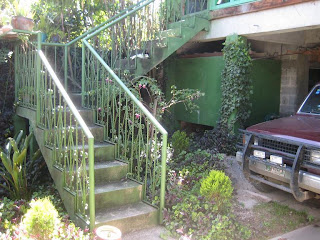My place in Nebaj is a good sized apartment with my own kitchen, bathroom, living room, bedroom, and office. The shower is the popular electrically heated showerhead. The house has a nice garden. The stairs you can see lead up to the upstairs apt, and the patio above is where I do my reading. I have seen these a lot in Central and South America. Produce is cheap, and I have fresh sqeezed orange juice and delicious Guatemalan coffee for breakfast with a piece of fruit. Corn tortillas are a staple here.

Once in the village I was asked if I had tortillas like this before. I said I did, in Mexico, but they were thinner.
He responded, "that's because in Mexico they're made from machine, here they're made from woman."
The villages are about what you'd expect. The homes have Corrugated metal roofs on single panel wood walls. Some have concrete floors, but most do not. Villages vary greatly in size. Cocks and hens roam freely, and the sheep, pigs, and goats are tied up. The damn kids run around yelling they're heads off. They speak little to no Spanish.
The people are nice, but it's hard to communicate. In this part of Quiche (the state) people speak Ixil. I work with Guatemalan masons who speak Ixil and Spanish. Things I need to know are translated for me. The food is generally hard boiled eggs in tomato sauce or black beans with onions always served with a healthy portion of corn tortillas. We drink water with mashed corn with the meals.
After the peace accords signed between the guerillas and the government the foreign aid came pouring into Guatemala and the country has seen a lot of infrastructure development in the last 15 years. Quiche was the most affected state during the war, and a hundred thousand refugees fled the already sparsely populated area. People have moved back into the area, but it remains lacking in basic infrastructure. The government promised a certain amount of water projects for each city that they have been slow (to say the least) at providing.





The projects we have going in the next few months are similar in nature. Spring capture is the most common way get a source of water. The water is fed using gravity and PVC pipes to a holding tank. The tanks are located above the village, and water is distributed to the village using gravity and PVC pipe. My job is to survey the pipe routes, then take this information back to Nebaj and analyze the data. We need to make sure we have sufficient water pressure to feed the system, so I adjust the route and size the pipe accordingly.
Project funding comes from a variety of sources. The Japanese consulate tends to donate a lot to the projects. Engineers Without Borders is currently funding two of our projects, and then groups like Water for People, Pure Water, International Water, and Global water all help out. Also, past volunteers are a source of funding.
Let me know if you have any questions or you would like more information about anything.




No comments:
Post a Comment